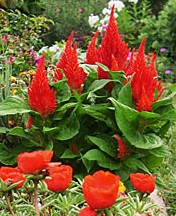 This combination depends on identical colors with contrasting texture for its effectiveness. Here I chose identical shades of orange but shades of red, yellow or pink would work as well. The smooth, satiny petals and the small succulent leaves of the moss rose contrast nicely with the fuzzy flower heads and large coarse leaves of the celosia. These common annuals are usually in bloom when you buy them so you can easy match the colors. The combination will last all summer into fall. Both plants do well in full sun and well-drained soil. The celosia resents drying out and profits from fertilizer during the growing season; the moss rose is more forgiving towards dryness and needs no fertilizer.
This combination depends on identical colors with contrasting texture for its effectiveness. Here I chose identical shades of orange but shades of red, yellow or pink would work as well. The smooth, satiny petals and the small succulent leaves of the moss rose contrast nicely with the fuzzy flower heads and large coarse leaves of the celosia. These common annuals are usually in bloom when you buy them so you can easy match the colors. The combination will last all summer into fall. Both plants do well in full sun and well-drained soil. The celosia resents drying out and profits from fertilizer during the growing season; the moss rose is more forgiving towards dryness and needs no fertilizer.

 Plumed Celosia (Celosia argentea var. plumosa)
Plumed Celosia (Celosia argentea var. plumosa)
The spikey upright flowerheads of celosia come in many different colors and with a variety of foliage colors including maroon and bronze tinged. Celosia also come in a variety of sizes but mid-height cultivars (12” or slightly taller) are best in this combination to form the backdrop for the ground-hugging moss rose. Many celosias reseed but the offspring may look entirely different from their parents.
-
Bloom Time: All summer to frost
Size: 6-24” H x 6-20”W
Hardiness: Zones 10-11’ (grown as annual elsewhere)
 Moss Rose (Portulaca grandiflora)
Moss Rose (Portulaca grandiflora) The charming 1-2” wide flowers can be single, semi double, or double but do not open on cloudy or rainy days. The stems are prostrate to slightly ascending and bear fleshy, medium green leaves 1-1½” long in clusters on red tinted stems. Plants may reseed.
The charming 1-2” wide flowers can be single, semi double, or double but do not open on cloudy or rainy days. The stems are prostrate to slightly ascending and bear fleshy, medium green leaves 1-1½” long in clusters on red tinted stems. Plants may reseed.
-
Bloom Time: Summer to frost
Size: 4-8” H x 12” W
Hardiness: Annual.
